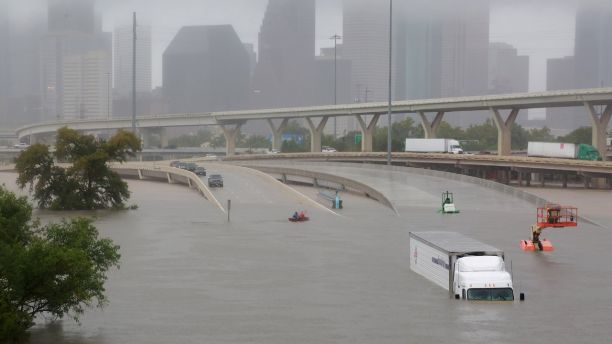 The unfolding tragedy in Houston from catastrophic rainfall and resulting flooding is probably worsened by two human-caused factors: climate change and bad land use planning. On the climate science, Michael Mann explains how warming waters in the Gulf of Mexico leads to greater rainfall:
The unfolding tragedy in Houston from catastrophic rainfall and resulting flooding is probably worsened by two human-caused factors: climate change and bad land use planning. On the climate science, Michael Mann explains how warming waters in the Gulf of Mexico leads to greater rainfall:
There is a simple thermodynamic relationship known as the Clausius-Clapeyron equation that tells us there is a roughly 3% increase in average atmospheric moisture content for each 0.5C of warming. Sea surface temperatures in the area where Harvey intensified were 0.5-1C warmer than current-day average temperatures, which translates to 1-1.5C warmer than “average” temperatures a few decades ago. That means 3-5% more moisture in the atmosphere.
That large amount of moisture creates the potential for much greater rainfalls and greater flooding. The combination of coastal flooding and heavy rainfall is responsible for the devastating flooding that Houston is experiencing.
But at the same time, the city is woefully unprepared for what appears to be a sadly predictable storm. Neena Satija previewed these events in a story last year in the Texas Tribune, in which she blamed poor local land use decisions for the city’s lack of resilience to this type of storm:
Scientists, other experts and federal officials say Houston’s explosive growth is largely to blame. As millions have flocked to the metropolitan area in recent decades, local officials have largely snubbed stricter building regulations, allowing developers to pave over crucial acres of prairie land that once absorbed huge amounts of rainwater. That has led to an excess of floodwater during storms that chokes the city’s vast bayou network, drainage systems and two huge federally owned reservoirs, endangering many nearby homes — including Virginia Hammond’s.
As my colleague Dan Farber notes on Legal Planet, this storm would have caused bad flooding no matter what. But locals throughout the country need to prepare for the “new normal” of climate change with storms and other events like these.
The resiliency planning will cost money and also mean other types of sacrifice. For example, in Houston’s case, large swaths of prairie should probably have been preserved rather than be developed. In other words, infill and smart growth development can be a crucial climate resiliency strategy. As a model here in California, I think of the Yolo Bypass by Sacramento and how that set aside of land for overflow from the Sacramento River saved the city from catastrophic flooding this year.
The events in Houston will hopefully be a wake-up call around the country that we need to preserve and bolster more natural systems to deal with the coming onslaught of extreme weather events, as well as build in smarter locations. And we’ll need forward-thinking people with the will to fund and implement these solutions.


